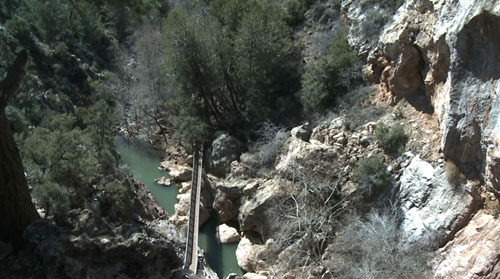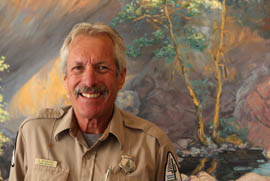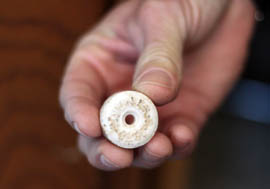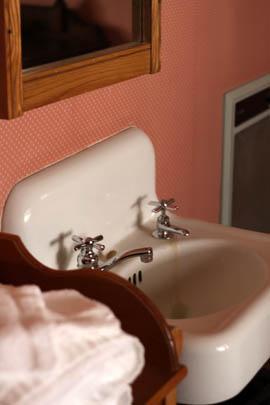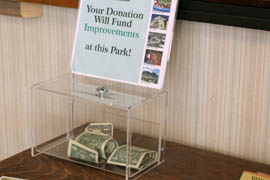Cronkite News has moved to a new home at cronkitenews.azpbs.org. Use this site to search archives from 2011 to May 2015. You can search the new site for current stories.
After lean years, Arizona State Parks looks to repair, update facilities
PAYSON – As manager of Tonto Natural Bridge State Park, Steve Jakubowski envisions a day when visitors will be to stay overnight at the 1920s-era lodge that houses the visitor center.
Doing so could boost park revenues and fund other improvements like new trees and cabins for Tonto, which became a state park in 1990.
But first the original knob and tube wiring must be replaced, a flammable, sugar cane-based compound used in the ceilings must be addressed and modern bathrooms must be added, along with an expanded system for managing sewage.
As it is, the lodge – and the entire park, for that matter – has just one flush toilet available to visitors. The other option is using one of many port-a-potties placed throughout the grounds.
“Modern flush restrooms have been put off for way too many years,” Jakubowski said. “We do have decent restrooms and we take pride in keeping them clean and sanitary for our visitors, but people really prefer a nice comfortable restroom to use.”
That would require money for repairs and upgrades, something that’s been in short supply at Arizona State Parks in recent years.
The agency has seen deep cuts in recent years as lawmakers addressed the budget deficit. It has received no general fund money since 2009, leaving it to operate primarily on gate fees.
Tonto, for example, is now open five days a week thanks to financial help from Payson, Star Valley and Friends of Tonto Natural Bridge State Park, a group dedicated to preserving the park and raising awareness.
This year, Gov. Jan Brewer’s proposed budget includes $2 million of Arizona Lottery proceeds to help Arizona State Parks address capital improvements.
Bryan Martyn, executive director of Arizona State Parks, has made capital needs a priority, saying state parks are forced to rely on outdated systems to keep revenue flowing.
“We’ve got water treatment plants that are older than me, even though the lifespan of a water treatment plant is only 40 years,” he said. “If the water treatment or the sewage treatment goes down, the park goes down.”
Jay Ream, deputy director of the Parks Division at Arizona State Parks, said the water treatment problems at Tonto are indicative of the challenges all state parks face.
“Let’s face it, we have port-a-potties, but people don’t really like using them because they smell more in the summer and they’re basically a glorified outhouse,” he said. “The ones at Tonto are brand new, but they’re not the solution for hosting people at a permanent recreation place.”
At Patagonia Lake State Park, he noted, the facilities date to the 1970s and the most recent bill to keep them operating was $60,000.
“We have some talented rangers at Patagonia keeping it going, but it’s out of date, out of compliance and really needs to be replaced,” he said. “Deferred maintenance will only get us so far until something needs to be completely replaced.”
Ream said a sewage plant upgrade at Slide Rock State Park cost $1.5 million. At Alamo Lake State Park, replacing the pump that sends the waste to the treatment plant cost $5,000 and had to be installed the same day a problem was discovered.
“But because we’re living paycheck to paycheck, closing something down and bringing it up to working order is really not an option for us,” he said. “It’s almost like putting new tires on an old car: You won’t get a flat, but something else will eventually go wrong.”
Ream said the well at Kartchner Caverns State Park uses the same water that runs through the cave. Unless an offsite water source is developed, the cave water will continue to be depleted. Ream said that project could cost anywhere from $2 million to $3 million.
At Tonto Natural Bridge State Park, bathrooms are the first of many things Jakubowski would like to see addressed.
With about 175 parking spots available, Jakubowski said it’s difficult to find room for everyone during the busier summer months, when upwards of 2,000 people visit each day.
“When the parking lot is maxed out, we have to hold up traffic coming into the park until spots clear out when people leave,” he said.
The historic lodge, which Jakubowski hopes to see opened to the public for weekend reservations by spring 2014, has been a work in progress since 1991. Some of the ceilings still contain Celotex, which is made of sugar cane and is highly flammable. The lodge finally replaced its old, leaky roof in 2009.
The outdated wiring was never designed to carry the electrical current of modern appliances, and when the wires get hot from increases in the electrical load they become potential fire hazards.
Martyn said the Arizona State Parks Board has even bigger plans for Tonto, including new shade and fruit trees and hiring a landscape architect to fix the incline of the lawn outside the lodge to make it more suitable for weddings.
In addition to renovating the lodge, Arizona State Parks wants to add cabins, which means adding more bathrooms. But doing that would mean developing a sewage treatment plant to dispose of the waste, Martyn said.
“This is where parks are going during some of the most challenging times in the history of state parks: trying to figure out how to enhance the resource and make some revenue while continuing to be an economic driver for the adjacent communities,” he said.

